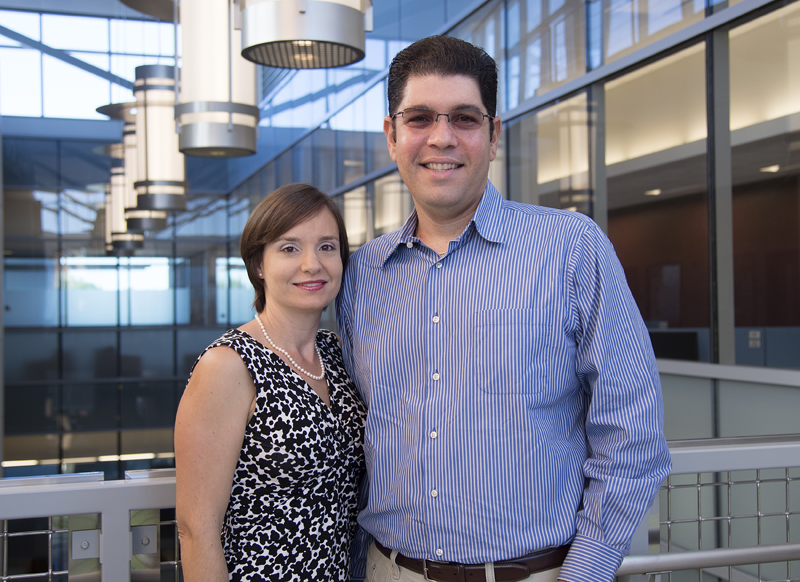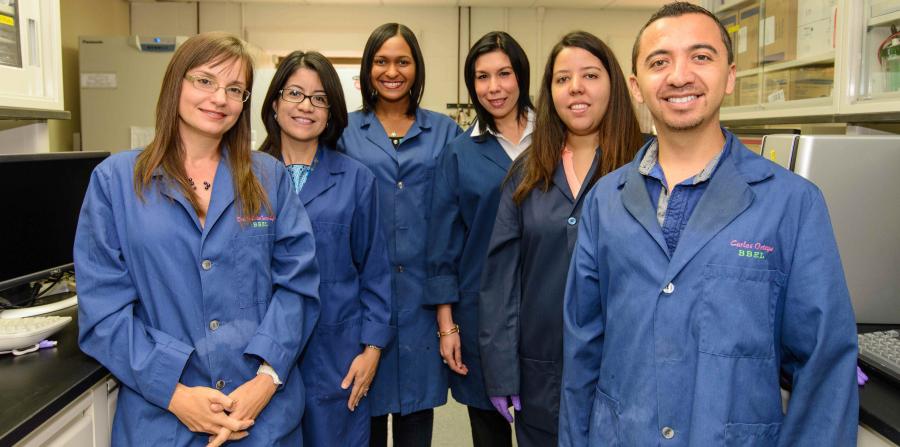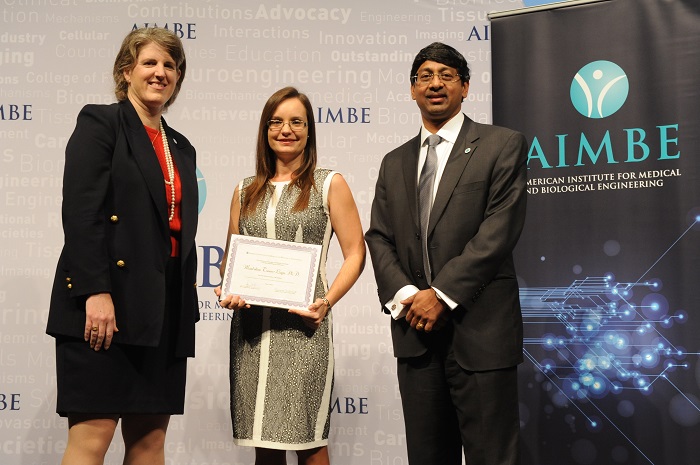Alumni power couple push bioengineering evolution in Puerto Rico

Today, Juan is professor of electrical engineering at UPRM and also adjunct professor of biomedical engineering at Purdue University. Torres-Lugo is a professor of chemical engineering at UPRM and adjunct professor of biomedical engineering at Purdue University.
But in the late 1990s, they were undergraduates who came to Purdue to participate in separate summer undergraduate research projects. It was only expected to be a summer abroad. But, it became a lasting partnership that has spanned two decades, two graduate degrees, two flourishing careers, and the evolution of biomedical engineering programs at both universities.
Indelible Impressions
Their summer research programs fostered important introductions on both sides. “That gave us an opportunity to see the place, to see the environment,” says Torres-Lugo. “It gave us the opportunity to get ourselves known there.”
They liked the place, and more importantly, the people they would be working with. So they applied to graduate school, Torres-Lugo in chemical engineering and Juan in electrical and computer engineering.
“They gave us both good offers. And that was important to us because we were engaged at that time.”
While the newlyweds immersed themselves in their graduate studies, major developments were underway in biomedical engineering at Purdue. The graduate program had just been approved. The William A. Hillenbrand Biomedical Engineering Center was renamed the Department of Biomedical Engineering. And George Wodicka—Juan’s advisor, was named head of the new department.
As Wodicka’s student, these advancements were in the backdrop of Juan’s experience at Purdue. Though at the time, he was focused on researching a technology that would improve the placement and monitoring of endotracheal tubes that are used in patients who cannot breathe on their own. The technology had promise. By the time he graduated, Juan, Wodicka, Jeff Mansfield (MS ’92, PhD ’96), and Greg Ayers (BSE ’85, PhD ’89) were in the process of launching a startup called SonarMed®.
The couple left Purdue in 2001 with their PhDs, a startup under way, and the promise of new careers at UPRM. They also carried home their first child—a son, born in West Lafayette.
Favorable Conditions
Observing the launch of the academic program in biomedical engineering and starting a medical device company infused them with an appetite for growth and impact.
“When we came back to Puerto Rico we were actually very excited about the biomedical engineering field,” says Juan.
They hoped to foster equal enthusiasm on the island among their peers, but it was a slow start.
“When we were hired there were only a few of us that actually worked in that area. So that was something that was not in the panorama at that moment,” says Torres-Lugo.
“There was a lot of skepticism of the field,” adds Juan. But, the conditions were favorable for change. “It was fateful that once Madeline and I started in Mayagüez, the field started to grow exponentially.”
The growth can be attributed to two key factors: the development of the field in general and its relevance to the Puerto Rican economy.
“It is an academic field that is growing in many universities across the world. Puerto Rico doesn’t have a program like that,” explains Juan. “And, bioengineering fits well with our economic development strategy in Puerto Rico. There are a lot of opportunities for bioengineering and biomedical engineering. We have many medical devices companies here.”
Thanks to federal tax incentives offered to U.S.-based manufacturers decades ago, the U.S. territory has become a worldwide pharmaceutical hub, one of the largest manufacturers of biotechnology, and a major exporter of medical devices.
Overcoming Skepticism

Torres-Lugo conducts research in the use of nanomaterials to diagnose and treat diseases more effectively and less invasively than traditional methods. When she started at UPRM, there wasn’t a facility available for this type of research.
“In chemical engineering there was nobody at that point working with mammalian cell culture,” says Torres-Lugo. “And very slowly through grants and so on I built a shared facility for cell culture and biological assays.” She directs the Center for Biomedical Engineering and Nanomedicine at UPRM, which is shared facility available at the University of Puerto Rico at Mayagüez.
“We provide support for people that are working in the field, people who would like to see their potential applications in the biomedical field and their materials but they don’t want to invest in a biofacility in order to test their materials.”
She also became the BioNano Group Leader at the Institute of Functional Nanomaterials (IFN), which is funded through an NSF EPSCoR program. The IFN provided the means to develop the research infrastructure to various interdisciplinary research groups spanning five UPR campuses and other universities. It has served as a catalyst for nanotechnology research in the island.
“I have been the leader for the past few years for that bio group. That’s one of the things that I’ve helped with here that has helped build the infrastructure for the bio people on the island.”
She also provides leadership for another interdisciplinary research group working on nanomaterials for biomedical applications. This grant is from the NSF-Center for Research Excellence in Science and Technology. The Center mission is to combine ongoing research and education efforts in nanostructured materials focusing on biomedical systems, environmental remediation, and sustainability.
Torres-Lugo and Juan have also joined forces as co-PIs on the Research Initiative for Scientific Enhancement (RISE) program, an NIH multi-million dollar multi-year award for a student training program. Through this program, they recruit students and motivate them to go to graduate school in either biomedical sciences or biomedical engineering.
Parallel Programs
Students pursuing graduate school have a new option on the island. Juan has steered the development of a graduate program in biomedical engineering at UPRM. The Puerto Rico Council of Education very recently approved the nascent program, and it launched in the fall of 2015.
Juan is co-PI on a multi-year, multi-million dollar grant to build infrastructure for the graduate program. “I am the leader of one of the activities of that grant, and one of the things we’re going to do is build an animal research facility on campus.”
When that facility materializes, the graduate program will have transitioned from an idea to a full-fledged program with a home.
“It’s been a long process,” says Juan. “We’re happy, but it’s taken about 10 years to get the program approved.”
The program is about where the Weldon School was ten or 15 years ago. “There are inspirations from the Purdue program, of course,” says Juan. “I have seen how they have grown from basically a graduate program within the College of Engineering to a full school.”
Juan has called on his former advisor from time to time as he has maneuvered through the process of developing the graduate program.
“George has always given us advice on how to do certain things, and now we’re excited to start the program.”
Juan and Wodicka plan to expand existing collaborations. UPRM graduate students will have opportunities to study at the Weldon School for a summer or a semester and vice versa. This will be an attractive recruitment tool for both institutions. They also envision growing existing research collaborations and writing grants together for new projects.
Public Policy
In addition to their work on campus, the couple has been very involved in establishing public policy for grants, entrepreneurship, and protecting intellectual property.
Juan’s experience launching SonarMed® afforded him a firsthand perspective of the process and challenges associated with licensing technology.
“In essence, having that experience at Purdue and my interest in science and engineering and their impact on economic development made me an advocate here in Puerto Rico. And that’s why all the passion for the graduate program and protecting intellectual property and getting it commercialized.”
“Everything Started to Click”

“Slowly with time and with progress and with achievement, people are actually now very excited about bioengineering, and they embrace it,” says Juan. “And they see it as part of the university. Whereas before it was like, ‘what?’ It’s been a very interesting transition from the early 2000’s to now.”
Torres-Lugo adds, “We have been for the past 15 years essentially leaders in building not only the research component of bioengineering here on the island, but also we have been leaders in building infrastructure and helping move the area forward at the same time. That’s the highlight of it all. We have been doing our research and we have been getting the grants and we have been publishing and we have been making impact. That’s how everything started to click.”
Torres-Lugo was recently appointed a Fellow of the American Institute of Medical and Biological Engineering (AIMBE), an honor reserved for the top two percent of the medical and biological engineers in the United States. Torres-Lugo is the only person in Puerto Rico recognized as a member of the AIMBE.
“For me it was a great honor. They invite you because they recognize the impact of your work. They saw our work, they saw what we are doing, and acknowledge that we have made a significant contribution in the field.”
Family First
The couple has stayed engaged with the Weldon School on various research projects and advisory roles. Juan is on the school’s advisory board. Torres-Lugo is on the board for a T-32 NIH Research Training Grant.
Those ties to the Weldon School bring them back to West Lafayette a few times a year. Their son, Esteban, came along once to see where he was born. He is 14 years old now. The family has also welcomed another son, Adrián, who is 9 years old.
With such a loaded plate of professional responsibilities, the couple says that the work/family life balance is their highest priority.
“We have to segment our time really well; that’s how we manage to do it,” says Juan. “We try to divide our time so that when we are at work, we do the most that we can in that time. And then once we leave in the afternoon, it’s family time.”
Torres-Lugo agrees. “We try as much as we can not to bring work home. The other thing is that we are very jealous with our time. We respect that very much. And if there are things that can wait, they’ll wait, because family’s first.”
Top Image: Madeline Torres-Lugo and Eduardo Juan.
Middle Image: Madeline Torres-Lugo and her team. From left to right: Torres-Lugo, Janet Mendez (research associate), Esmarline de Leon (undergraduate student), Marisel Sanchez (post doctoral student), Noelia Almodovar (MS student, graduated summer 2015, currently in the PhD program in chemical engineering at Purdue), Fernando Merida (PhD student). Not pictured: Karem Court (PhD student).
Bottom Image: Madeline Torres-Lugo is appointed a Fellow of the American Institute of Medical and Biological Engineering (AIMBE).

